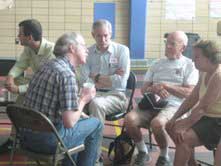
|
The
proposed Union Square Station gets Somerville residents talking. ~Photo
by Nick Bonard of the Somerville Community Corporation. |
|
Community
involvement has played a large role in bringing the Green Line to
Somerville. The proposal to extend the Green Line came after the state
of Massachusetts settled a lawsuit with the Conservation Law Foundation
by promising to offset the effects of pollution brought on by the Big
Dig. With help from local groups, including the Somerville
Transportation Equity Partnership (STEP), the Green Line Extension was
written into legislation in 2006.
STEP has joined forces with
Groundwork Somerville, the Somerville Community Corporation, and the
Somerville Community Health Agenda to form the Community Corridor
Planning (CCP) group. CCP is providing the opportunity for continued
community involvement in the planning stages by organizing seven
meetings in Somerville neighborhoods with proposed stops on the Green
Line Extension. Meredith Levy, Director of Community Power and
Resources at the Somerville Community Corporation, says the CCP is
committed to involving community members in projects that will have an
impact on daily life for years to come. The hope is that these meetings
will engage people in the planning process who may not normally be
involved.
The Green Line Extension, planned to open in 2014,
includes a branch that will connect Union Square with a newly designed
Lechmere station. Saturday saw the fifth of the seven meetings, this
one to discuss the Union Square stop and its impact on the community.
Representatives from Save Our Somerville, Tufts University, STEP, and
residents from Union Square and neighboring areas of Somerville came
together to discuss what this change will mean for Union Square. A
thoughtful, if small, group discussed hopes for positive impact from
the Green Line Expansion and concerns that ranged from public safety to
increases in property taxes. The meeting included those new to the
Union Square area, and some residents who have lived nearby for over 40
years.
The group's ideal outcome of the Green Line Extension
included a vision of Union Square as a diverse center for residents and
a variety of businesses thriving, creating access to better jobs for
people of all income levels. Residents also expressed concerns about
the possibility of increased taxes, displacement of residents and local
businesses, and public safety and security around a new transit hub.
Overall, the vision encompassed an idea of reduced vehicle traffic and
improved access to the proposed location of the Union Square stop,
including coordination with buses, access to bike lanes and walking
paths, and accommodations for seniors and people with disabilities.
Wig
Zamore, an active member of STEP, talked about the environmental
benefits of the Green Line Extension with regard to traffic reduction.
Currently, Zamore says, Somerville has the highest vehicular traffic of
any city in the state. Three highways run through Somerville, carrying
200 to 250 thousand cars a day and there are 6 diesel rail lines that
carry 200 trains through Somerville each day. Somerville shoulders much
of the burden of air pollution due to commuter traffic, but receives
little of the benefit of transit with only one T stop in Somerville in
Davis Square.
Levy states that many of the themes coming up in
discussion at the Corridor Planning meetings resonate throughout the
community, regardless of the neighborhood in which the meeting is held.
Residents value many of the same things, including maintaining the
diversity of Somerville. And the organizations behind the Community
Corridor Planning Project aim to represent the many Somerville voices
in an effort to achieve responsible and equitable transit development
that can be used as a model for the state or cities around the country.
|
Reader Comments